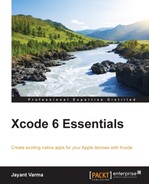Book Description
Create exciting native apps for your Apple devices with Xcode
In Detail
Apple made their iOS devices easy to use and now they have extended that to their development tools such as Xcode. In Xcode, you can create native applications in the easiest way. Apple's new Xcode technology is making the development curve smoother with its easy-to-develop features and enhancements.
Xcode can now write code with the performance-upgraded, brand new, innovative language called Swift, so you no longer need to rely on third-party frameworks to create applications.
The book gives you a tour of the new features of Xcode 6. It introduces some important aspects such as the Swift language and its Playgrounds with visual live coding, creating interfaces, storyboards, controllers, frameworks, and live previews. Diving more into the subject, this books shows you how to debug your code, and how to build and test the application on a device or the simulator.
What You Will Learn
- Create a complete project using Xcode and build native apps for Apple devices
- Learn the basics of Swift, get started with coding, and program your own app quickly
- Learn to design your UI in the storyboard rather than recreating it in a mockup tool and importing it to Xcode
- Discover the basics of creating a custom control with live previews in Interface Builder
- Migrate your custom code into frameworks
- Get familiar with debugging and troubleshooting your code
- Package your code and build for the App Store
Downloading the example code for this book. You can download the example code files for all Packt books you have purchased from your account at http://www.PacktPub.com. If you purchased this book elsewhere, you can visit http://www.PacktPub.com/support and register to have the files e-mailed directly to you.
Table of Contents
- Xcode 6 Essentials
- Table of Contents
- Xcode 6 Essentials
- Credits
- About the Author
- About the Reviewers
- www.PacktPub.com
- Preface
- 1. Introduction to Xcode
- 2. Tour of Xcode
- 3. Playgrounds
- Introduction
- Swift Playgrounds
- Learning Swift
- Console output printing
- Working with variables
- Control flows and code execution
- Functions
- Objects
- Extensions – extending the classes
- Summary
- 4. Interface Builder
- 5. Custom Controls
- 6. Debugging
- 7. Building and Running
- A. Conditional Execution and Interface Designing
- Index
